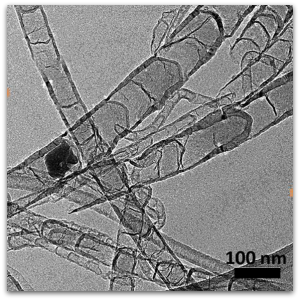
The new, inexpensive catalyst could lead to the transformation of CO2 into green fuel.
Image: Angewandte Chemie
On a global scale, carbon dioxide (CO2) is the number one contributor to dangerous greenhouse gas emissions. Increasing levels of CO2 accelerate the devastating effects of climate change, such as rising sea levels and a higher global temperature. In order to reduce these emissions, researchers are tackling projects from the implementation of a clean energy infrastructure to scrubbing CO2 from the atmosphere. The researchers from the University of South Carolina are exploring even another innovative way to reduce CO2 emissions by turning the harmful byproduct into fuel.
The team, led by ECS member Xiao-Dong Zhou, is looking for a way to harness CO2 emissions that already exist in the environment and use green technologies to inject energy and produce fuel.
Making Green Fuels
While 100 percent renewable energy may be the ultimate answer for the energy infrastructure, it is difficult for industrialized countries that heavily depend on traditional combustion technologies to make that transition so rapidly. The implementation of wind and solar technologies on the large scale also raises question to grid efficiency, reliability, and storage.
One solution to this issue is by using technologies such as solar and wind to turn harmful CO2 emissions into clean, usable fuels.
Read the paper in the journal Angewandte Chemie.
This from the University of South Carolina:
If you could add some energy to it, though, you could convert CO2 into carbon compounds that are fuels, not a waste product. In chemical parlance, it’s called reducing CO2 when you convert it to less-oxidized forms of carbon, all of which have actual fuel value. Some single-carbon molecules to aim for would include (in increasing energy content) carbon monoxide (CO), methanol, and methane.
Step in the Right Direction
“We are working in conjunction with other institutions, and they are developing the other side, the water side, using photovoltaics to split water, and eventually we want to couple those two reactions together,” says Zhou. “So one side will be water splitting, generating protons from the anode that travel through the electrolyte to reach the cathode side and then react with carbon dioxide and with incoming electrons to convert carbon dioxide to fuels. Carbon monoxide is one kind of fuel you can produce, and methane and methanol are other fuels that can be produced.”
Zhou’s team also included ECS student members Pranav P. Sharma and Christopher J. Wright.
While this development will not lead to commercialization of the technology, it is a step in the right direction.
“There’s still a long way to go,” says Zhou, “but it’s a start.”


